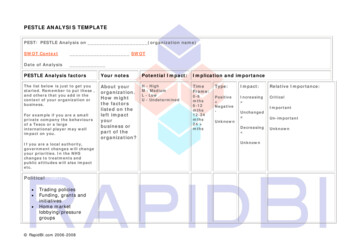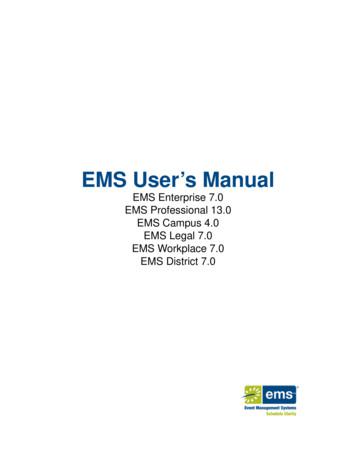University Of Worcester EMS PESTLE Analysis 2017
University of the Worcester EMS PESTLE AnalysisPolitical issuesExternal issuesChanges to government policyChanges to taxes/leviesInfluence from NGO's, unionsor other external bodies.General public pressuresRisksChanges to policy may put public funding ofhigher education at risk e.g. research grants. Areduction in overall funding may reduce theresources allocated to the EMS.An increase in taxes may reduce funding forthe EMS.*Unions may highlight poor environmentalperformance;*Funding bodies may place further sustainabledevelopment requirements on institutionswhich entails additional resource.Risk of not meeting public expectations forenvironmental performance.OpportunitiesGovernment policies may incentivise theinstitution to address sustainable developmentissues in order to reduce costs.An increase in tax linked to energy or waste mayincentivise the institution to become moreefficient*Incentivise good environmental managementpractice.*Student engagement opportunities forsustainable development initiatives.Adds pressure to ensure good level ofenvironmental performance.League tablesReputational damage.Adds pressure to ensure good level of sustainabledevelopment performance.British exit from EU (BREXIT)Potential risk of environmental policy andlegislation change.RisksRisk of losing supportive management staff.Reduction in budget for EMS and sustainabledevelopment initiatives.May reduce red tape.Internal issuesRestructuring - ManagementBudget reallocationEMS AspectOpportunitiesOpportunity to engage with new staff members.Increase in budget for EMS and sustainabledevelopment initiatives.Communicationand communityactivitiesCommunicationand communityactivitiesEMS Aspect1
Varying focus of managementduring term timesLack of commitment during peak times.Resistance to changeLack of commitment from staff.Restructuring Strategies/PolicyPotential for focus to be reduced from EMS.Opportunity to implement sustainabledevelopment initiatives during quite periods inpreparation for student return.Opportunity to engage with staff.Communicationand communityactivitiesOpportunity to ensure that environmentalmanagement and sustainable development isconsidered within institutional strategy.Economic issuesRisksA downturn in the economy may negativelyimpact the institution's investment in sustainableinitiatives.OpportunitiesPresent opportunities for investments inenvironmental initiativesIncreased taxation may reduce funding availablefor EMS.Increased costs to ensure compliance.Increased taxation may incentivise investment intosustainable development.Forces spending on environmental management.Energy costsIncrease in energy costs may decrease fundingavailable for the EMS.Electricity andnatural gasconsumptionAvailability of fundingPrevious government policy changes have allowedUniversities to charge higher tuition fees but havealso reduced public funding.* Incentive to reduce energy consumption andinvestment into energy saving initiatives* Increased energy prices may decrease thepayback periods for energy efficiency projectsThere are funding schemes available forinstitutions e.g. Revolving Green Fund.Internal issuesRisksRe-allocation of funds away from EMS and relatedinitiatives.OpportunitiesRe-allocation of funds for EMS and relatedinitiatives.EMS AspectExternal issuesChanges to economicclimateChanges to taxes etc.Legislation changesBudget changesEMS AspectElectricity andnatural gasconsumption2
Cost of EMSInstitution's financialperformanceSignificant decisionsChanging student numbersDifficult to demonstrate return on investment ofEMS. May lead to lack of support frommanagement.Poor financial performance may lead towithdrawal of funding from EMS.* The institution's strategic direction may notalign with the intended outcomes of EMS.* Large capital projects may not sufficientlyaddress sustainable development issues.Higher proportion of HE institution funding islinked to tuition fees therefore greater emphasisplaced on retaining student numbers.Demonstrating return on investment mayincentive further support for EMS.Positive financial performance may lead to furtherfunding for sustainable development initiatives.*Opportunity to address sustainable developmentissues early on in capital development process.SustainableconstructionChanges to higher education funding placesstudents as consumers having a greater impact onthe type of service universities provide. NUSresearch has illustrated sustainability is a keyfactor for students when evaluating a university.Social issuesExternal issuesSocietal pressures andcultural trendsMediaIncreased expectationsfrom stakeholders fororganisations todemonstrateenvironmentalresponsibilityImpact of climate changeon societyInternal issuesRisksLack of sustainable development responsibilitymay damage institution's reputation if exposed.Opportunities* Opportunity to publically announce improvedenvironmental and sustainable developmentperformance is;*Incentive to address environmental issues.EMS AspectCommunicationand communityactivitiesGreater expectation from society forenvironmentally responsible organisations. Risk ofbeing exposed if not environmentally responsible.Increased expectation to address environmentalissues may act as an incentive.Communicationand communityactivitiesRisksOpportunitiesEMS Aspect3
Staff and studentengagement andexpectationsDemographicsLack of engagement may reduce effectiveness ofEMS.Increased expectations make it easier to engagestaff and students.Sustainable development initiatives may be haltedby certain groups e.g. Objections to wind / solarprojects from local communities.Changing demographics may increase support forsustainable development initiatives.Expectations of internalstakeholder groups - SU,staff, student bodiesStaff retentionLack of stakeholder pressure may detract focusaway from the EMS.Stakeholder pressure may incite investment intosustainable development initiatives.Sustainable developmentawarenessHigh staff turnaround can negatively affect EMSthrough lack of engagement.Lack of awareness can hinder EMS progress.Communicationand communityactivities* Increased sustainable development awarenesscan make it easier to engage staff and students;* A lack of awareness may present opportunitiesfor behavioural change.Technological issuesExternal issuesAdvances in technologyCostsFunding availability fortechnologiesInternal issuesRisksTechnological development has the potential toincrease energy use is more technology isembedded across the University estate.High technology costs with relatively long paybackperiods can reduce uptake of new technologies.OpportunitiesThe continual emergence of new technologiespresent opportunities to address sustainabledevelopment issues.Costs of technologies will likely fall over timebecoming more financially viable.EMS AspectElectricity andnatural gasconsumptionA reduction in the financial incentives fortechnologies may make it harder for the institutionto achieve carbon reduction targets e.g. Closure ofFeed in tariff scheme.RisksExternal funding available for carbon reductiontechnologies.Electricity andnatural gasconsumptionOpportunitiesEMS Aspect4
Implementing newtechnologyIntended outcomes may not be achieved ifimplemented incorrectly.New technology can be used to help achievesustainable development objectives in areas suchas energy, waste and water.*Electricity andnatural gasconsumption*Watermanagement*WastemanagementUse of new technologyTechnologies may not be used to full capacity e.g.complex energy monitoring systems are only usefulif data is used to manage energy consumption.Hot desking / remote working may reduce energyand transport emissions.Existing infrastructureRisk of increased energy consumption for old,inefficient equipment.Opportunities to upgrade equipment to meetenergy reduction objectives.Electricity andnatural gasconsumptionRisks* Prosecution for non-compliance* Costs associated with tax, levies and finesOpportunitiesIncentive to manage environmental responsibilitiesEMS AspectLegal issuesExternal issuesNew legislationCost of complianceBREXITIncreased costs of compliance may detract fundingfrom other areasThe UK leaving the EU may lead to changes inenvironmental legislation and relaxed or increasedregulationInternal issuesAwareness/keeping up todateStaff knowledgeRisksLack of knowledge, understanding andaccountability of legal requirements can lead tonon-complianceThe UK leaving the EU may lead to changes inenvironmental legislation and relaxed or increasedregulationOpportunitiesOpportunities to engage with staff to ensurecomplianceEMS AspectCommunication5
ResponsibilityAccountabilityOperational changes cost/trainingEnforcementResistance to comply due to extra resourcesrequiredLack of enforcement from regulatory bodies canmake it difficult to demonstrate the need tocomplyEnvironmental issuesExternal issuesInstitution's impact onthe environmentClimate changeRisks* Pollution to air, land and water* Ecosystem damage* Nuisance* Waste* Natural resource consumption etc.Opportunities* Enhance biodiversity* Improve environmental sustainable developmentperformance via EMS* Increased energy consumption* Disruption to institution's operations* Increased flood riskIncreased awareness of climate change mayincentivise sustainable development improvementprogrammesEMS Aspect*Promotion andprotection ofbiodiversity*Control ofemissions to air*Control ation*Watermanagement*Electricity andnatural gasconsumption*Sustainabletransport6
Resource availabilityInternal issuesExisting infrastructureLocationCapital development* Potential for limited resource availability in thefuture* Cost of resources likely to increase as supplyreducesRisksOlder building can detract from organisationsenergy efficiencyClose proximity to sensitive areas may increase riskof local environmental damageIncreased use of resourcesDevelop re-use initiatives for waste* Managementof equipmentcontaining F-gasand tunitiesEMS AspectUtilise local environment as source of staff/studentengagement* Sustainable buildings* Opportunities to enhance biodiversity*Sustainableconstruction7
University of the Worcester EMS PESTLE Analysis Political issues External issues Risks Opportunities EMS Aspect Changes to government policy Changes to policy may put public funding of higher education at risk e.g. researc
EMS API Reference Guide 2012 Dean Evans & Associates, Inc. CONFIDENTIAL 20 Aug 2012 9 EMS Professional customers – enter “EMSData” EMS Workplace, EMS Campus, EMS Enterprise, EMS Legal and EMS District customers - typically named “EMS” 9.
PESTLE ANALYSIS TEMPLATE PEST/ PESTLE Analysis on _(organization name) SWOT SWOT Context _ SWOT Date of Analysis _ view PESTLE Analysis factors Your notes Potential Impact: Implication and importance The list below is just to get you started. Remember to put these ,
EMS User’s Manual EMS Enterprise 7.0 EMS Professional 13.0 EMS Campus 4.0 EMS Legal 7.0 EMS Workplace 7.0 EMS District 7.0
Ed Hill, Senior EMS Coordinator, Kern County EMS Kara Davis RN, EMS Systems Director, NorCal EMS Chris Clare RN, Data Systems Manager, Los Angeles County EMS . California EMS System Core Quality Measures 4 Table of Contents EMS System Core Quality Measures Project
County EMS Agency Field Operations Guide An operational guidance document for EMS Agency Personnel, EMS Duty Chief, EMS Commander, and EMS Director REFERENCE #817 Revised November 2008 Santa Clara County Emergency Medical Services Agency 976 Lenzen Avenue San Jose, California 95126 1. . EMS field units (EMS 2-6/Squad1),
PESTLE analysis is, in effect, a broad assessment of the key features of the external environment facing a business. Developed since the late 1960s, a PESTLE analysis delves into six key factors affecting a company's operations: Political, Economic, Social, Technological, Legal and Environmental (or Ethical).
The EMS Workforce Guidelines document foundation is in both the EMS Workforce Assessment and the EMS Workforce Agenda. The primary objective of the EMS Workforce Assessment was to, “address issues relevant to the process of workforce planning.” 8 The EMS Workforce Assessment provides a listing of 12 critical policy issues
9 MATHEMATICS - Week 1 Lesson 2: Properties of Operations Learning Objectives: Students will be able to simplify computations with integers, fractions and decimals by using the associative and commutative properties of addition and multiplication, and























